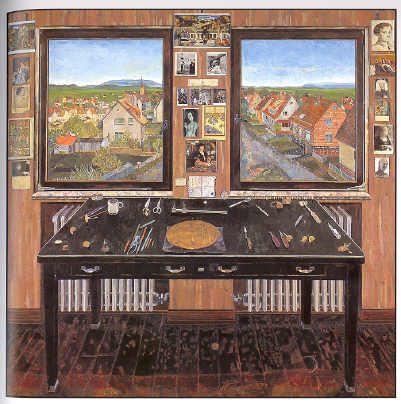| |
|
 |
 |
| |
|
"Lafcadio Hearn" in The
Art of Lafcadio Hearn:
Lafcadio Hearn / Guy Davenport ; On Collecting Lafcadio Hearn /
Clifton Waller Barrett. Published to Accompany an Exhibition
1 May -- 20 August 1983,
in the Departments of Rare Books and Manuscripts of the University of Virginia Library.
(Charlottesville, VA: University of Virginia Library, 1983), pp. [7-9])
Pamphlet is unpaged [19 pp.] illus (part col.)
Dimensions: 5.5 by 8 in. (14 by 20 cm).
Comments (verso title page):
"The cover illustration 'The
Moonrise,' is reproduced from the original watercolor by Lafcadio Hearn in the
Clifton Waller Barrett Library.
The frontispiece is from the
cabinet photograph of Lafcadio Hearn, New Orleans, June 1, 1887, in the
Clifton Waller Barrett Library.
The emblem seal used as an
ornament is Lafcadio Hearn's personal mon comprising the characters for
his adoptive Japanese name, Koizumi Yakumo, meaning 'a small spring' and
'eight clouds.' Koizumi was Hearn's wife's Samurai family name and the
Yakumo is the first part of the most ancient extant poem in the Japanese
language. It also evokes the Yakumo Mountains area--the first place Hearn
loved in Japan. . . . "
Colophon:
"The Lafcadio Hearn
exhibition was organized and arranged by Robert A. Hull, Library Assistant in
the Manuscripts Department; Michael F. Plunkett, Assistant Curator of
Manuscripts; and Joan St. C. Crane, Curator of American Literature
Collections. This keepsake, in an edition of 1500 copies, was set and
printed at the University of Virginia Printing Office."
Foreword:
"Guy Davenport's essay
furnishes fresh reasons for a reconsideration of Lafcadio Hearn's place in
American Literature. Hearn's superficial image as a merely exotic writer is
dispelled by Professor Davenport's assessment, which contains rich meat for
several book-length dissertations. If a subtle and complex artist can be freed
from a dreary stereotype., Professor Davenport has made a beginning toward the
liberation of Lafcadio Hearn. . . ." (Joan St. C. Crane)
Excerpt from GD's essay:
". . . [Hearn]
longed to fuse Herbert Spencer and Buddhism. The extent to which he did could
be seen at Pearl Harbor, and can still be seen in Japanese industry. He was a
major energy in explaining Japanese culture to the West, while culminating his
busy life as teacher and writer by explaining the West to Japan. The
radiant lines that can be traced from Hearn's presence in Japan seem to go on
and on. Witness Hearn reading Yeats to his students at Tokyo University. Then
regard Yeats and Pound and their Certain Noble Plays of Japan. These
come by way of Ernest Fenollosa, Hearn's colleague, but the ground for them
was prepared by Edward Sylvester Morse, Percival Lowell, Raphael Pumpelly, and
Hearn -- a collegium of cultural technicians whose attention enriched
the West as powerfully as a vision of Greece and Rome fascinated Europe in the
Sixteenth Century. The walls of Monet's house at Giverny were hung with a good
hundred wood-block prints by Hokusai, Hiroshige, Sharaku, and other masters of
ukiyoe. The Japanese sense of space, color, and moment came into
western painting through Whistler, Van Gogh, Monet, and Mary Cassatt. The
Japanese donation instigated new styles of poetry through Pound, H. D., and
Amy Lowell, and new styles in architecture through Frank Lloyd Wright. One
could go on: interior decoration (the folding screen, tea tables, bamboo),
gardens, philosophy.
If Hearn's participation in
opening our eyes to the East is fairly well known, and his enrichment of our
sense of local color through his importation of French precisionist and
impressionist prose into the American heartlands, his alertness in the
literary avant-garde is harder to appreciate. One example must serve:
Hearn translated Flaubert's Tentation de St. Antoine. This invisible
event, still unnoticed, is characteristic of Hearn's fate, and a measure of
his genius. The translation was not published until six years after his death,
and was bowdlerized. (Hearn as a schoolboy had had to suffer a Jesuit's
drawing britches and skirts on the illustrations in a book Classical art which
he had been given, and his Tentation -- out of print for forty years,
in any case -- is still decorated here and there with the leaf of the fig.)
This seminal book Flaubert's inspired the Circe chapter of Ulysses,
Wyndham Lewis's Childermass, Wilde's Salome (by way of
Flaubert's own stylistic redaction of the Tentation in 'Herodias'), and
even Beckett's "Happy Days'. Hearn's sense of the work's place in our
culture's imagination was absolutely correct. . . ."
|
| |
|
|
|
| |
|
"Robot" in William Abrahams, ed.,
Prize
Stories 1974: The O. Henry Awards,
(Garden City, NY: Doubleday, 1974), pp.
186-214.
First published in the Hudson Review 25:3 (Autumn
1972), pp. 413-446.
|
| |
|
|
|
| |
|
"The Richard Nixon Freischütz Rag" in
William Abrahams, ed., Prize Stories 1976:
The O. Henry Awards,
(Garden City, NY: Doubleday, 1976), pp. 66-74.
First published in the Hawaii Review (Spring 1975)
56-64.
|
| |
|
|
|
| |
|
"The Richard Nixon Freischütz Rag" in
William Abrahams, Prize Stories of the Seventies:
From the O. Henry Awards.
Selected and with an introduction by William Abrahams,
(Garden City, NY: Doubleday, 1981)
pp. 249-257.
Introduction refers to GD's "assemblages" (GD's
word) in this story as a "masterly set of juxtapositions" of private lives with
public events. (pp. 7-10).
First published in the Hawaii Review (Spring 1975)
56-64.
|
| |
|
|
|
| |
|
"Pound et Frobenius" in Les
Cahiers de L'Herne 7: Ezra Pound
[special issue] no. 2,
(Paris: Editions de l'Herne, 1965), pp. 667-680.
Translated by Pierre Alien.
"Qu'Ezra Pound en soit arrivé à la sérénité
confucéenne, où que le puma soit toujours aux aguets dans sa cage, il est difficile
de le dire ...
Excerpt from Andrew Crosland, "Annotated
Checklist of Criticism on Ezra Pound, 1961-1965: Part III" Paideuma
9:3 (Winter 1980) pp. [521] - 548., at item #195:
195. Special Pound Issue. Les
Cahiers de L'Herne, Nos. 6-7, 1965.
Two numbers of L'Herne are devoted
entirely to Pound in commemoration of his eightieth birthday. This 700-page
tribute includes translations into French of some of Pound's poems, critical
essays, and letters. In addition to this primary material, the tribute also
contains transcripts of interviews with Pound, critical evaluations of his
writings, memoirs, and bibliographies of work by and about him. Some pieces
are written especially for this issue; others are reprints; almost all are
in French. A number of interesting photographs are also included.
Annotations follow for all written contributions to the issue which treat
the poet and are not by him." (p. 531)
"Pound and Frobenius" was
published first in Lewis Leary, ed. Motive and Method in 'The Cantos' of
Ezra Pound (NY: Columbia University Press, 1954)
* * *
Crosland provides a summary
of this essay at item # 195.20:
In this essay . . .
Davenport suggests that Frobenius is a cultural anthropologist whose
importance has not been sufficiently recognized. Further, Pound is said to
have derived much of his thinking about culture from Frobenius. Passages
from the Cantos and from the poet's critical writings are offered as
evidence. (p. 534)
|
| |
|
|
|
| |
|
"Finding" in Robert Atwan and William
Vesterman, 100 Major Modern Writers:
Essays for Composition,
(Indianapolis, IN: Bobbs Merrill, 1984), pp. 138-148.
First published in Antaeus 29 (Spring 1978) 61-69.
|
| |
|
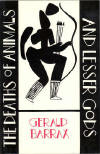 |
|
| |
|
[Drawing] in Gerald Barrax, The
Deaths of
Animals and Lesser Gods, (Lexington, KY: Charles H. Rowell, Editor and Publisher,
University of Kentucky, 1984). (Callaloo Poetry Series, volume 4)
"Art and front cover design by Guy Davenport."
|
| |
|
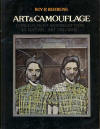 |
|
| |
| "Preface" in Roy R. Behrens,
Art &
Camouflage: Concealment and Deception in Nature, Art, and War, (Cedar
Rapids, IA: The North American Review [and] The University of Northern Iowa, 1981), p. 7. . |
| |
|
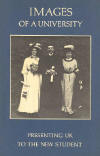 |
|
| |
"A Liberal Education" in Raymond F. Betts
and John B. Stephenson,
eds., Images Of A University: Presenting the University of Kentucky to the New
Student, Sponsored by the Office of the Dean of Undergraduate Studies. (Lexington, KY: University of Kentucky, 1977), pp. 35-38.
Excerpts:
"Education in schools
began about 2700 years ago in the Greek city of Sparta. There had been
education for millions of years before that, but not in schools. The
children of prehistoric hunters must have been taught quite early in
their lives how to rob a nest of eggs, how to throw a spear, how to
dance and sing. At the dawn of history we find schools of astronomy
and mathematics, of theology and and magic, but these were centers of
learning where scholars taught scholars. The sending of children to
school to be taught skills appropriate to civilized people was an
invention of the Greeks.
Societies at the time
of the rise of education were divided into free men and slaves. The
slaves learned skills such as carpentry, masonry, cooking, and so
forth; the children of free men were given a liberal education. That
word, liberal, derives from the Latin word meaning free.
We still keep the phrases 'liberal education' and 'the liberal arts'
to indicate education the value of which is spiritual and
philosophical rather than technological."
* * *
"The American
university has evolved into a special kind of institution. In 1910 it
decided to let the student choose his own courses: the elective
system, begun at Harvard (but you still had to have permission of your
minister to substitute French for Hebrew as your language
requirement). The great Swiss biologist Louis Agassiz (1807-1883) who
came to teach in the United States urged the American universities to
teach practical skills as well as academic subjects. He felt that it
was very much a part of the democratic spirit to teach agriculture,
military skills, engineering, mining, and other technological
knowledge. Thus the American university became a blend of the
philosophical and the technical; a new kind of school in the history
of the world.
The process of
learning in this new kind of university can therefore range from deep
to shallow, serious to superficial, profound to useless -- the
more liberal a system the more it can be abused. The art of being a
student is something the student has to discover. He may well feel
like a religious man attending all the churches in the world.
University teachers are specialists: your English teacher will demand
skill in language as if that were the most important thing in the
curriculum, while your mathematics teacher will treat you as if the
world ate, breathed, and slept mathematics. The ideal student will try
to satisfy the claims of all his teachers, for the process in which he
is involved is invisible and with surprises ahead. All real knowledge
is accumulated in ignorance of what it will lead to. We can be
reasonably sure that education will always lead to something,
ignorance to nothing."
* * *
"The serious student
is probably always one who is motivated by intellectual curiosity
rather than by the demands of teachers. Courses are introductions to
subjects, the opening of a door which no one but you can enter. The
success of an education is known only years after graduation from a
university; not even the wisest botanist can see the oak in the acorn.
The serious student
is also, paradoxically, the one who learns for the fun of learning,
who follows his appetite rather than a prescribed diet. Intelligence
at its best is always a little crazy. The university is the only place
in our world where you can be interested in anything and everything,
and probably the only place where the free exercise of the mind is
thoroughly respectable. . . . [L]ots of knowledge appears
to be arbitrary and pointless until you have enough of it to see how
it fits together; much must be done with faith and patience (and in
fits of the dumps and frustration), but you are carrying on an
enterprise that began 2700 years ago, and which must go on for as long
as we remain civilized people."
|
| |
|
|
|
| |
"Two Poems" in William Blackburn, ed.,
Under
Twenty-five: Duke Narrative and Verse, 1945-1962, (Durham, NC: Duke
University Press, 1963), pp. 19-21. Poems entitled "Exact Observations" and
"The Fox".
|
|
|
|
|
|
|
|
|
"Foreword" in Fredson Bowers, ed., Vladimir
Nabokov, Lectures on 'Don Quixote', (San Diego, CA; New York: Harcourt Brace
Jovanovitch; Bruccoli Clark, 1983), pp. xiii-xix.
First published as "Don Quixote Restored" New
York Times Book Review (February 13, 1983) 3, 34-35
|
| |
|
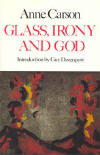 |
|
| |
|
"Introduction" in Anne Carson,
Glass,
Irony, and God. New York: New Directions, 1995.
"First published as New Directions Paperbook 808 in
1995."
|
| |
|
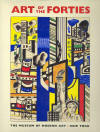 |
|
| |
| "Civilization and its Opposite in the
Nineteen-forties" in Riva Castleman, ed.,
Art of the Forties, (New
York: The Museum of Modern Art, Distributed by Harry N. Abrams, 1991), pp. 15-32. . |
| |
|
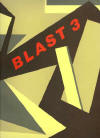 |
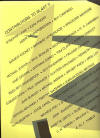 |
| |
|
"The Bowmen of Shu (illustrated by Henri
Gaudier-Brzeska and the author)" in Seamus Cooley, ed.,
Blast 3,
(Santa Barbara, CA: Black Sparrow Press, 1984), pp. 77-95.
First published as The Bowmen of Shu. New York:
The Grenfell Press, 1983.
|
| |
|
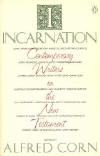 |
|
| |
|
"The Second Epistle of Paul the Apostle to Timothy"
in Alfred Corn, ed., Incarnation: Contemporary Writers on the New Testament,
(1990; reprint New York: Penguin Books, 1991), pp. 237-246. Originally published
as Contemporary Writers on the New Testament: Incarnation, (New
York, Viking Penguin, 1990).
In this essay, following a contrasting of Jesus and Paul, and
of the oral and written legacies of Christianity, GD reflects upon the influence of religion
on his writing, especially stories gathered in Tatlin!, Eclogues, Apples
and Pears, and The Jules Verne Steam Balloon. "When, some fifteen
years ago, I began to write stories, [he says] I found that I was assuming that my subject
was precisely this dialogue between Jesus and Paul, and that the student teaching what he
had learned was a process that engaged my imagination and my moral sense." (p. 242)
Excerpts:
For wee wrestle not against flesh and blood, but against
principalities, against powers, against the rulers of the darknes of this world, against
spirituall wickednes in high places. -- Ephesians 6:12 (1611)
This sentence, in
which we can see oiled athletes grappling in the dust of a gymnasium
at Tarsos, was first written down, from Paul's dictation, by his
secretary Tykhikos, around the year 60, when Nero was still sane and
Plutarch, over in snowy Boiotia, was an adolescent about to set out
for Athens to study mathematics and philosophy with Ammonius, who like
Jesus and Paul, was a peripatetic teacher.
What interested me in this strong sentence when I came across it out
of context, having previously paid more attention to the sentences
before and after . . . was Paul's seeming to have a good word to say
about the flesh. The context was Blake's The Four Zoas,
where it serves as epigraph and is in Greek. Blake was a congenial
Christian and, like Kierkegaard and Bunyan, had the gift of analogy
and integrating vision which makes a prophet a prophet.
* * *
)
|
| |
|
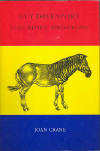 |
|
| |
|
Crane, Joan. Guy
Davenport: A Descriptive Bibliography,
1947-1995. Compiled by Joan Crane with the assistance of Richard Noble. Introduction
by Hugh Kenner. Haverford PA: Green Shade and James S. Jaffe Rare Books, 1996. 550 copies
printed.
"Frontispiece [two drawings] by Guy
Davenport, from [his] Da Vinci's Bicycle" (verso t-p)
"Page of Workbook [by
Davenport]" (p. [viii])
"Copyright 1996 by Joan St.
Clair Crane
Designed by Thomas Meyer;
dust jacket concept by Thomas Meyer, designed by Leslie Miller of the Grenfell
Press, New York City
Note: I was surprised
to see my name included on the Acknowledgements page, most likely for
something Ms. Crane culled from our conversations about GD's work.
|
| |
|
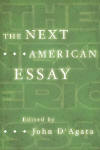 |
|
|
|
"And" in
John D'Agata, ed. The Next American Essay. (Saint Paul, MN:
Graywolf Press, 2003), p 5.
"And" was first published in A Table
of Green Fields (NY: New Directions, 1993).
|
| |
|
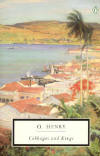 |
|
| |
"Introduction" in
O. Henry:
Cabbages and Kings. With an Introduction and Notes by Guy Davenport,
(New York: Penguin Books, 1993), pp. vii-xix. (Penguin Twentieth-century Classics) with
"Explanatory Notes" pp. 229-231.
William Sydney Porter
(11 September 1862 Asheville, NC -- 05 June 1910 New York, NY) He wrote
under the pen name, O. Henry. He died under the pseudonym, Will S.
Parker.
"Suggestions For
Further Reading" (pp. xxi-xxii).
"The interpretation of
independent tales into a long narrative is a device that goes back to
Homer. The Golden Ass, of Lucius Apuleius (2nd century A.D.).
intersperses its simple plot . . . with bawdy tales related by
characters and one bright myth, the tale of Cupid and Psyche. There are
cycles of stories, like The Thousand Nights and One Night (an
analogue O. Henry was fond of invoking in all of his books) and The
Canterbury Tales. Collections of short stories, whether by
Washington Irving or Chekhov, usually have some thematic or geographic
coherence.
O. Henry invented in
cabbages and Kings a new reshaping for a cycle of stories in that he
emphasizes an architectonic form rather than an organic one. That is,
his form is abstract. There is a plot . . . but the texture and tone of
the narrative do not depend on the plot and frequently do not serve it.
In fact they impede the plot, and , as in Tristram Shandy, we are happy
with this process of dallying and delay: we soon learn that it is the
essence, the meat, of O. Henry's style.
It was also the
beginning of a style in modern writing. A dozen years later came
Dubliners, a round of stories in a strict order and with an
architectonic pattern overlying the whole. Sherwood Anderson's
Winesburg, Ohio has a similar organization, as does Eudora Welty's
Golden Apples." (p. viii)
|
| |
|
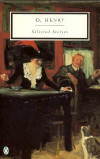 |
|
| |
"Introduction" in
O. Henry: Selected Stories. Edited
and with an Introduction by Guy Davenport, (New York:
Penguin Books, 1993), pp. ix-xviii. (Penguin Twentieth-century Classics)
"Suggestions For Further Reading" pp. xix-xx.
Edition includes eighty
stories from the following dozen O. Henry books:
- The Four Million
(1906)
- The Trimmed Lamp
(1907)
- Heart of the West
(1907)
- The Voice of the
City (1908)
- The Gentle
Grafter (1908)
- Roads of Destiny
(1909)
- Options
(1909)
- Strictly Business
(1910)
- Whirligigs
(1910)
- Sixes and Sevens
(1911)
- Rolling Stones
(1912)
- Waifs and Strays
(1917)
"If Washington Irving,
whom O. Henry admired and thought of as an ancestor in the matter of
writing about New Yorkers, wrote for the harpsichord, and Poe for the
cello, then O. Henry was the Scott Joplin of prose stylists." (p. xi)
"O. Henry's literary companions were ones
he never met: Robert Louis Stevenson, Kipling, Mark Twain, and the
unknown author of The Thousand Nights and One Night. The wonder
is that their influence was so invisibly absorbed. from all of then
(Along with Omar Khayyam) he took the understanding that a story is a
calculation of fate, independent of a philosophy or religion, and that
the art of tale-telling is a high skill deriving from observations,
experience, and insight into human character. He did not challenge any
of the writers he admired on their own ground (except for the one
Stevensonian hommage). Nor did he ever write an autobiographical
line. All of his work is a miracle of imaginative projection." (p. xvii)
GD includes this essay
in The Hunter Gracchus with the title "O. Henry".
|
| |
|
 |
|
| |
"The Art of
Simon Dinnerstein" in
Simon Dinnerstein: Paintings
and Drawings; [with commentary by] Rudolf Arnheim, Guy Davenport,
Robert L. McGrath, John Russell, Edward J. Sullivan, Miller Williams. (New
York: Hudson Hills Press, 1999), pp. 1-3.
Paperback binding, 9
in-by-12 in., 117 pp. illus. (part col.). My copy signed by artist.
Cover: Passage of the Moon,
1998 (oil and gold leaf on wood panel, 74.5 by 67.5 in.)
Excerpts from GD's commentary:
? |
| |
|
"Appendix G: Text Collation" in John
Hamilton Edwards and William W. Vasse, eds.,
Annotated Index to 'The Cantos' of Ezra
Pound: Cantos I -- LXXXIV, (1957; reprint Berkeley, CA: University of
California Press, California Library Reprint Series, 1971)
Appendix G, pp. 313-322.
Appendix G contains the results of a collation of the
two texts: The New Directions
edition (second printing, second state, dated 1948, released 1952) and the Faber edition
(1954) of The Cantos.
"The provisional collation prepared by Mr. Guy
Davenport for the Pound Newsletter served as a point of
departure for this textual study." (p. 313)
|
| |
|
|
|
| |
|
Guy Davenport included in the list "100 Other Distinguished Short
Stories of the Year 1979" in Stanley Elkin [editor] The
Best American Short
Stories 1980, (Boston: Houghton Mifflin, 1980), unpaged.
For GD's story "John Charles Tapner"
published in the Kenyon
Review (New Series 1:1 (Winter 1979)) pp. 122-132.
|
| |
|
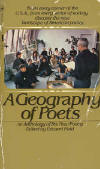 |
|
| |
"The Medusa" in Edward Field,
ed. A
Geography of Poets: An Anthology of the New Poetry.
New York: Bantam Books, 1979. 560 pp. GD poem at pp. 320-321.
"DAVENPORT, Guy: 'The Medusa' is
reprinted by permission of the author."
(p. 544, extension of 'Copyrights and Acknowledgements' continued from
page iv
(verso t p)
|
| |
|
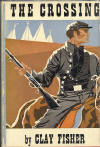 |
|
| |
|
[Dust Jacket Drawing] in Clay Fisher, The
Crossing. Boston: Houghton Mifflin, The Riverside Press Cambridge, 1958.
"First Printing"
"Jacket by Guy Davenport"
Clay Fisher is a pseudonym for Will Henry.
|
| |
|
|
|
| |
| |
|
"Robot" in Margaret Foley, ed., The
Best American Short Stories 1973 & The Yearbook of the American Short Story,
(Boston, MA: Houghton Mifflin, 1973), pp. 67-98.
First published in the Hudson Review 25:3 (Autumn
1972), pp. 413-446.
|
| |
|
|
|
| |
|
Guy Davenport listed on the "Roll of Honor, 1976" in
Margaret Foley,
ed., The Best American Short Stories 1977; and the Yearbook of the
American Short Story, (Boston: Houghton Mifflin, unpaged.
For GD's story, "C. Musonius Rufus" published
in the Hudson Review 29:1 (Spring 1976), pp. 19-44.
|
| |
|
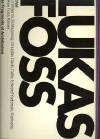 |
|
| |
|
"The Fragments of Archilochos" in Lukas
Foss, Echoi; The Fragments of Archilochos; Non-Improvisation [Musical
recording], (Baden Baden: WERGO Schallplatten GmbH; Mainz: B. Schott's Söhne,
Musikverlag, 1968), WER 60040. Sound recording, analog ; 33 rpm ; 12 inch vinyl.
Program booklet (two sheets, 30 cm by 30 cm) accompany vinyl disc and its
sleeve.
Music was performed at Potsdam, NY: State University College
at Potsdam, by the Crane Collegiate Singers. Performers: Robert Betts, tenor;
Miriam Abramowitsch and Melvin Strauss, readers; Oswald Rantucci, mandolin; Jonathan
Marcus, guitar; Jan Williams, Edward Burnham, Lynn Harbold, 'Schlagzeug'.
Excerpts from program notes:
Am 3. Februar gab Abraham Kaplan und der 'Collegiate Chorale'
in der Philharmonic Hall die erste New Yorker Aufführung seiner 'Archilochos Fragmente',
eine Vertonung (in offener Form) von Übersetzungen altgreischer Satzfragmente.
Die < Fragmente von Archilochos > ins Englische
übertragen von Guy Davenport. Auftrag des < State University College >,
Potsdam, New York, für Helen Hosmer.
Archilochos (714 -- 676 v. Chr.), nach Homer der bedeutendste
griechische Lyriker, Erfinder der Jamben, ist uns nur in Fragmenten erhalten geblieben.
Seine Themen: Leben, Liebe, Krieg und Tod. Soll durch seine scharfe
Feder mehrere Zeitgenossen in den Selbstmord gestürzt haben.
In dieser und drei anderen Kompositionen verwendet Foss eine
Technik, die ermöglicht, daß jede Aufführung anders ausfallen kann, ohne jedoch das
Resultat dem Zufall zu überlassen: er schreibt eine Partitur, die auf jeder Seite
weit mehr enthält als die Aufführung benutzt, denn für jede Seite (jede Phrase) wird
eine Auswahl entweder nach einem Schema (Spielplan) oder frei getroffen. Die
Partitur von 12 Phrasen wird dreimal hintereinander gespielt; jedes Mal wird anderes
Material kombiniert, und zwar gibt es auf jeder Seite etwa 325 verschiedene
Kombinationsmöglichkeiten.
Foss sagt: 'Ich habe die Fragmente von Archilochos so
zusammengestalt, daß jede der vielen Kombinations-moglichkeiten interessante
Uberraschungen bringt, nicht nur musikalisch sondern auch textinhaltich. Gewisse
Sätze nehmen eine verschiedene Bedeutung an, bekommen einen anderen Sinn, wenn die
Reihenfolge der Sätze umgestellt ist, oder ein Fragment plötzlich allein dasteht, das
man vorher mit anderren verbunden vernommen hat. So wird eine ernste Behauptung in
wechselndem Zusammenhang vielleicht zum Witz. Da uns nur Fragmente erhalten sind,
sind alle diese Interpretationen mögliche Formen der Absicht des Dichters.
An excerpt from a table of fragments.
Complete table has 12
rows and 7 columns, labeled 'A' through 'M', but with 'J' omitted:
"The Fragments of Archilochos translation by G.
Davenport, selection and order by the composer [Lukas Foss]"
| A |
uninspired but sentimental over one
sadness or another |
we complain, we dream, we blame. |
what breaks me, young friend, is
tasteless desire, dead iambics, boring dinners |
season follows season |
you've bolted the door. |
old and at home |
time grows old. |
| B |
ignorance of the good of things |
a measured motion governs man. |
but iron bends, too, and that poker is
limp as a rag. |
be bold, that's one way. |
kindness flows both ways. |
desire, future, enemy. |
i'm worn out |
| .
. . |
.
. . |
.
. . |
.
. . |
.
. . |
.
. . |
.
. . |
.
. . |
| L |
delirium of ares. hot tears cannot
drive misery away nor banquets and dancing make it worse. |
wild animals. begotten by their
fathers' roaring farts. |
swordwork and spear-sticking. battle
trumpet. wandering aimlessness of evil. |
<intentionally left blank> |
wild animals, wild of mind, wandering
hungry, stirred up and raving, eaten by fleas. |
wandering aimlessness of evil. |
you bring home a bright evil. remember
us--remember this earth. in the hot work of slaughtering. voracious even to the bounds of
cannibalism. listen--hear me--what we don't expect comes fearfully. a bright evil. |
| M |
quiet. attribute all to the gods. |
may the dog days blister the lot. |
hang iambics, this is no time for poetry. |
keep a quiet heart. |
come down among us, o zeus, the ground is
our blood. |
we crossed a harvest of our dead.
recompense. |
the gods toughen us to stand this pain. |
|
| |
|
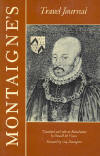 |
|
| |
| "Foreword" in Donald M. Frame, tr.,
Montaigne's
Travel Journal, (San Francisco: North Point Press, 1983), pp. vii-xi. |
|
|
| |
|
|
Back to Parts of
Books (All) |















